How to Evaluate and Improve Delivery Time KPIs
Updated on
April 24, 2024
by
Alina Kostukova
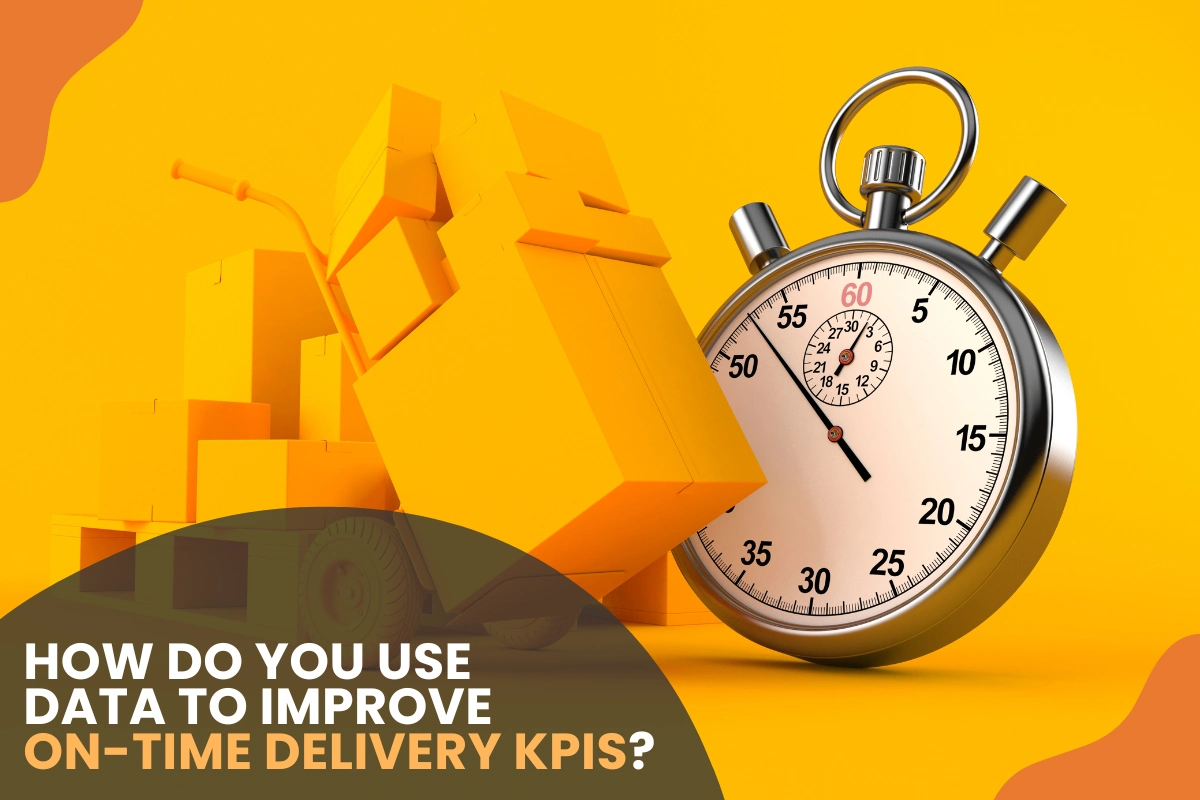
In the contemporary business landscape, on-time delivery (OTD) has transformed from a desirable quality to an indispensable one due to fierce competition. OTD represents the proportion of orders successfully delivered to consumers within the specified period.
Deliveries consistently made on time result in satisfied consumers, strengthened brand loyalty, and substantial financial gain. However, exceptional OTD rates can be difficult to attain, particularly for expanding wholesale businesses.
In this situation, data analytics serves as a strategic asset. Using data, one can acquire significant knowledge regarding delivery procedures, detect obstacles that impede progress, and execute data-centric tactics to enhance operations to achieve punctuality.
We analyzed over 1.5 million deliveries tracked using Track-POD (find the full research here) in 2023, and found that just 44.3% of all deliveries were completed on time, while the rest were completed outside of the original ETAs.
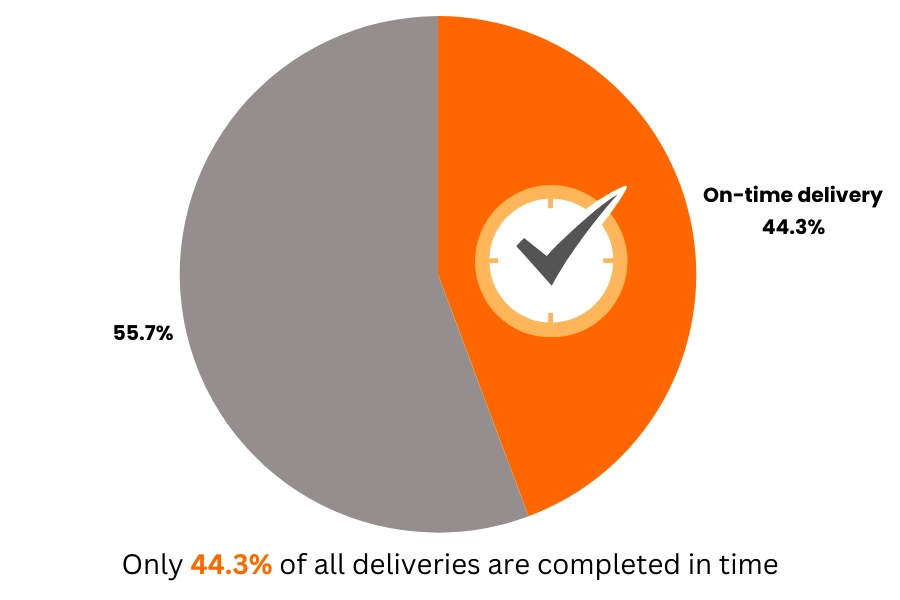
Understanding OTD in business
Logistics and supply chain management employ on-time delivery (OTD) as a critical performance indicator (KPI) to assess the effectiveness of a specified delivery system.
It signifies the percentage of consumer orders delivered to them within the designated period. 90% would illustrate an OTD rate if 90 out of 100 orders were consistently delivered on time.
Several interconnected metrics offer a more detailed assessment of your delivery performance:
Beyond the fundamentals: additional OTD metrics
Although OTD offers a broad perspective, there exist additional pertinent metrics that provide a more detailed analysis of your delivery performance:
- Delivery In Full On-Time (DIFOT):
This metric surpasses conventional delivery time measurements by assessing the inclusion of all the accurately ordered products in the shipments. - Ideal Order Fulfillment Rate:
This metric surpasses DIFOT by taking into account not only on-time and complete deliveries but also the condition of the order, including its integrity and the accuracy of any accompanying documentation. - On-Time In Full (OTIF):
Analogous to DIFOT, OTIF evaluates punctual deliveries by emphasizing specific order lines instead of the entirety of the order, provided that the orders are complete and accurate.
We published a separate article on measuring and improving DIFOT and OTIF. Take a look at it here.
Why is precise OTD measurement crucial?
Accurate OTD KPIs measurement is essential for identifying delivery process improvement opportunities. The following is why:
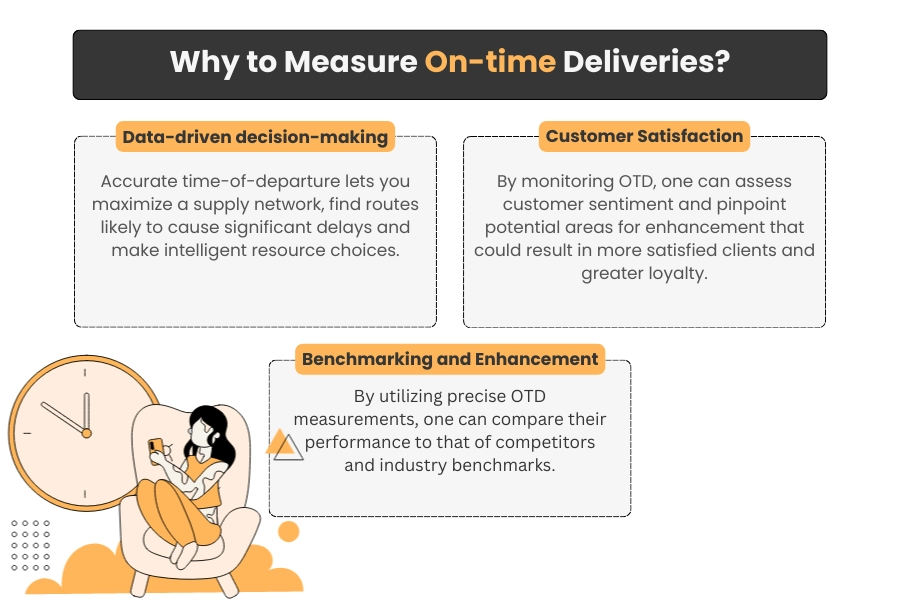
- Data-driven decision-making:
Accurate time-of-departure lets you maximize a supply network, find routes likely to cause significant delays and make intelligent resource choices. - Customer Satisfaction:
How happy customers are with your business directly relates to how often orders are made on time. By monitoring OTD, one can assess customer sentiment and pinpoint potential areas for enhancement that could result in more satisfied clients and greater loyalty. - Benchmarking and Enhancement:
By utilizing precise OTD measurements, one can compare their performance to that of competitors and industry benchmarks. This functionality establishes attainable objectives and monitors advancements in pursuing exceptional delivery performance.
By comprehending and precisely quantifying OTD and its associated metrics, one acquires invaluable insights that enhance delivery processes to ensure consistent on-time accomplishments.
Analyzing on-time delivery performance
Data analysis isn't just a theory; it's a powerful tool companies can use to get big jumps in OTD rates. Let's look at some examples from real life that show how useful data-driven ideas can be:
Case Study 1: Amazon's anticipatory shipping
Amazon has revolutionized on-time delivery with its anticipatory shipping method, which utilizes predictive analytics to enhance delivery efficiency.
By analyzing a vast array of data points such as customer purchase history, search patterns, and regional sales trends, Amazon pre-ships products to strategic locations even before customers place orders.
This proactive approach not only streamlines the delivery process but also minimizes customer waiting times.
Once a potential buyer's data indicates a likely purchase, the item is quickly routed from the nearest hub, significantly reducing delivery times and improving customer satisfaction.
This anticipatory model showcases how leveraging big data can transform traditional shipping and logistics operations, making them more responsive and cost-effective

Case Study 2: Magazine Heroes masters urban deliver in the UK
Magazine Heroes Ltd efficiently managed a complex urban delivery challenge for Procter & Gamble in the UK using Track-POD's software, pivotal for planning and executing routes for over 16,000 sample boxes.
The software's advanced analytics played a crucial role, allowing for dynamic route adjustments and comprehensive data collection that met stringent tender requirements.
This capability streamlined operations amid an outdated client list and routes with up to 300 stops and significantly enhanced service reliability and compliance, demonstrating the transformative power of integrated delivery management analytics in urban logistics.
Case Study 3: Uber Eats and real-time data analytics
Uber Eats employs real-time data analytics to ensure timely food deliveries, a critical factor in customer satisfaction.
The platform gathers and analyzes data on various aspects of the delivery process, including restaurant preparation times, driver locations, and current traffic conditions.
Using sophisticated algorithms, Uber Eats can predict the fastest delivery routes and match orders with the nearest available driver. This dynamic system improves delivery times and enhances the overall customer experience by ensuring meals are delivered hot and fresh.
This example highlights the importance of real-time data in optimizing logistical operations and enhancing service delivery in the fast-paced food delivery industry.
Strategies for improving delivery times with data
Data analysis is no longer a luxury but a tool for achieving shorter delivery times and happy consumers. Let's look more at how businesses of all sizes can use data to better their delivery processes:
1. Improving supplier OTD
On-time delivery is a joint effort. Analyzing past data on supplier performance allows you to spot patterns and red flags affecting your total OTD rate. Here's how data can help you become a better partner with your suppliers:
Identifying bottlenecks
Analyze information on order fulfillment timelines, shipment delays, and communication breakdowns. This could indicate chronically late delivery from specific suppliers, untrustworthy transportation partners that cause delays at origin points, or ineffective customs clearance processes.
Proactive collaboration
With these insights, you may collaborate with your suppliers to solve the underlying problems. Negotiate harsher delivery terms with unreliable vendors or use bonus programs to incentivize on-time performance. Diversify your supply base to reduce the risk associated with a single source. Collaborate with suppliers to improve origin logistics and identify potential bottlenecks.
Data-driven supplier selection
When evaluating new suppliers, use data to analyze historical performance in areas like as lead times, specification conformance, and communication responsiveness. This data-driven method might assist you in establishing a network of dependable partners who contribute to constant, on-time delivery.
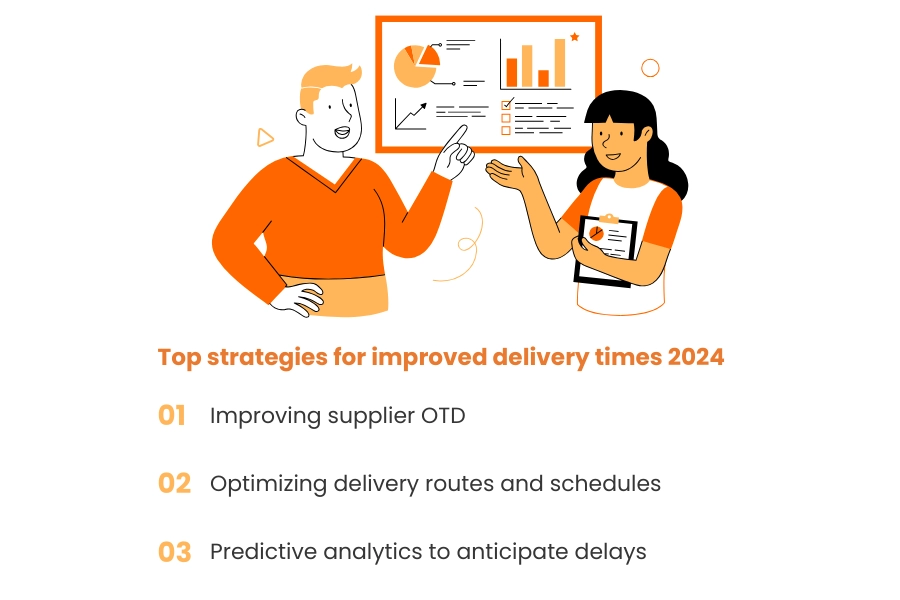
2. Optimizing delivery routes and schedules
Delivery routes should be dynamic and responsive to changing conditions. Data analysis can be an effective technique for route optimization, resulting in considerable improvements in OTD rates:
Uncovering inefficiencies
Analyze previous delivery data, such as delivery times, distances traveled, and driver performance indicators. Identify places with frequent congestion, imbalanced workloads causing delays for individual drivers, or improper route assignments that result in costly backtracking.
Dynamic route planning
Use specialist software to combine historical data with real-time traffic conditions and weather trends. This allows you to design dynamic routes that cut travel time and fuel consumption and ensure on-time deliveries.
Data-driven scheduling
Examine historical delivery times for different routes and order complexities. This information can aid in developing realistic schedules that account for uncertainties and minimize false expectations.
3. Predictive analytics to anticipate delays
The value of data extends beyond examining past performance; it can assist in foreseeing future difficulties and keep them from affecting your OTD rates. Predictive analytics enables proactive problem-solving.
Forecasting potential issues
Use historical data and machine learning techniques to anticipate future delays before they happen. Analyze weather patterns, traffic congestion trends, and previous delays on specific routes to identify high-risk regions for delays.
Proactive contingency plans
With probable delays forecast, you can implement contingency plans to minimize interruptions. This could include reassigning deliveries to substitute drivers who are more available, altering warehouse pick-up schedules to prevent congestion, or notifying anticipated delays to clients in advance, allowing them to adjust their expectations.
Companies that use these data-driven tactics can alter their delivery operations, achieve large increases in OTD rates, and establish a reputation for dependable and efficient deliveries.
On-time delivery calculation
Irrespective of an organization's magnitude, on-time delivery (OTD) is a performance metric within the wholesale distribution industry. It indicates the proportion of consumer orders that were delivered as requested and on schedule.
A high OTD rate leads to satisfied customers, increased brand loyalty, and a significant increase in your bottom line. But how do you accurately evaluate your OTD performance? Here is a full, step-by-step guide on how to figure out your OTD rate.
Step 1: Define your Delivery timeline
Before calculating your OTD, you must establish what timeframe is deemed "on-time" for delivery. This window could be based on several things, including:
- Standard Delivery:
The standard delivery duration you provide to clients by default. - Faster Delivery:
Optional expedited delivery can be requested for an additional charge. - Guaranteed Delivery:
Deliveries not meeting the specified time frame are accompanied by a money-back guarantee.
Regardless of the schedule, deliver consistent updates to clients regarding the timeline via order confirmation emails and at the time of placement.
Step 2: Gather data
To calculate your OTD rate, you will require two crucial data sets:
- Total Orders:
The number of orders placed per week, month, or quarter. - On-Time Deliveries:
The number of orders completed and shipped on time, regardless of transportation method.
The necessary information can be available via your order management system or warehouse management system. If your systems cannot track OTD specifically, you can construct a custom report identifying shipped orders and their matching delivery dates.
Step 3: Apply the OTD formula
Once you have your data, compute your OTD rate using the following formula.
OTD Rate (%) = (Number of On-Time Deliveries / Total Orders Shipped x 100)
Let's say you sent out 100 orders in one week. 85 of those orders were fulfilled within the timeframe indicated. Applying the formula:
OTD Rate = (85 On-Time Deliveries/100 Total Orders Shipped) x 100 = 85%
As a result, your OTD rate for the week is 85%.
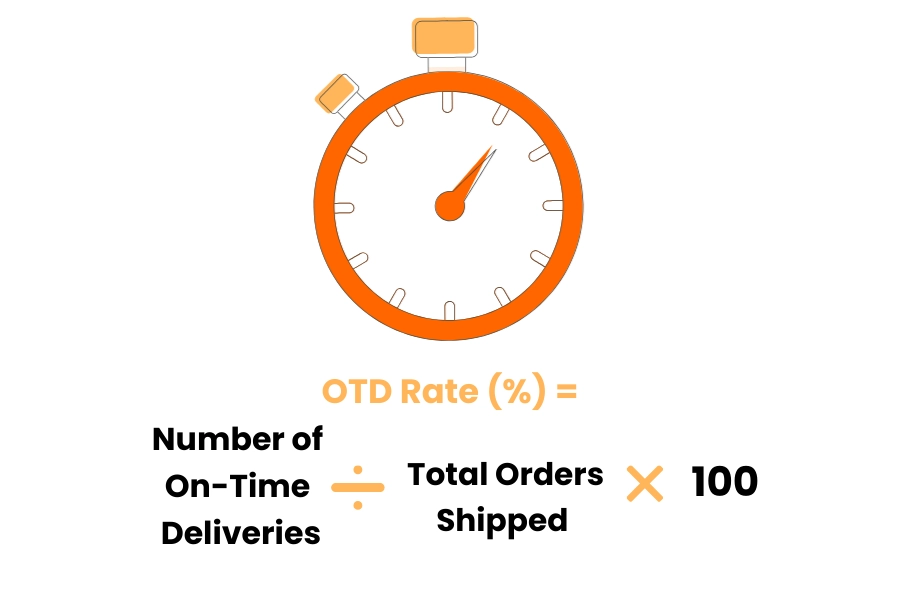
Step 4: Important factors and additional metrics
Consideration should be given to any delivery window flexibility that you may offer your clients when calculating your OTD. An instance of unforeseen circumstances in which a customer consents to receive a product one day after the initial commitment could still qualify as "on time" according to the terms of your agreement.
Partial Delivery: How do you handle partial deliveries? Should the full order be deemed late if part of it is delivered on time but the rest arrives later? Determine a clear policy for how incomplete deliveries affect your OTD estimates.
While OTD is an important statistic, consider using additional metrics to get a complete picture of your delivery performance. This could include:
- DIF: The proportion of shipments received undamaged and in their entirety.
- DIFOT: The percentage of completed and delivered on time, calculated by combining OTD and DIF.
- Perfect Order Fulfillment Rate: This measure expands on DIFOT by considering order accuracy and damage-free deliveries.
By considering these factors and employing additional indicators in addition to OTD, you acquire a better knowledge of your delivery performance and can discover areas for improvement.
Step 5: Analyze and improve
Calculating your OTD is just the beginning. Monitor your OTD rates regularly to uncover patterns and opportunities for improvement. Investigate the causes of late deliveries and use the information to apply data-driven optimization solutions, such as:
- Supplier selection and performance management are now more effective.
- Route planning based on traffic and weather information.
- Predictive analytics is being used to forecast future delays.
- Better contact with customers about delivery updates.
By adopting a data-driven approach to delivery management, you can consistently improve your OTD rate and establish a reputation for dependable and efficient deliveries, resulting in increased customer satisfaction and business success.
Leveraging technology for better OTD
Technology is paramount in enhancing delivery processes and attaining outstanding on-time delivery (OTD) rates in today's data-driven society. Organizations of any scale can effectively utilize specialized software and platforms to gather, assess, and respond to critical delivery-related data, thereby converting observations into practical approaches that ensure timely accomplishments.
Most successful businesses will also invest in software designed to enhance the delivery process, from route planning software to IVR phone systems for customer service lines.
Here are some significant technical solutions that can empower organizations to use data for better OTD:
Warehouse management systems (WMS)
A WMS software optimizes warehouse operations by managing inventory, picking routes, and packaging. Inadequate picking strategies or stock inconsistencies are examples of constraints in a warehouse that can be identified by WMS data and linked to delivery delays. The subsequent utilization of this data can enhance delivery efficiency and streamline warehouse operations.
Order management systems (OMS)
An OMS serves as a centralized center for handling all aspects of the order fulfillment process. It allows you to enter order information, monitor inventory levels, and create shipping labels.
Modern OMS solutions use analytics to track delivery delays, including order processing speed, picking and packaging efficiency, and carrier performance.
Route optimization software
This software analyzes traffic patterns, weather conditions, and delivery locations to find the most efficient delivery routes for your drivers. This not only saves travel time and fuel but it also ensures on-time delivery and increases driver productivity.
Real-time tracking and traceability solutions
These solutions provide real-time information about your items' position throughout delivery. This allows you to anticipate future delays and offer changes to customers. Historical tracking data can also be utilized to study trends and identify potential route improvements.
Track-POD: A powerful tool for data-driven delivery management
Track-POD demonstrates how technology can improve on-time delivery using data analytics. Here's how Track-POD helps firms achieve OTD excellence:
- Comprehensive Data Collection:
Track-POD collects a plethora of data throughout the delivery process, including order details, driver GPS tracking, proof-of-delivery signatures, and timestamps. This broad data gathering enables a detailed examination of delivery performance. - Actionable Insights:
Track-POD's built-in analytics provide helpful information about critical variables such as OTD rates, delivery timeframes by location, and driver performance. This enables organizations to discover areas for improvement and make data-driven decisions to optimize routes, increase driver efficiency, and, eventually, achieve more excellent OTD rates. - Improved Communication:
Track-POD enables real-time communication between drivers and clients. Drivers are given clear directions and can update their status, while clients can follow their deliveries in real-time and receive automated reminders regarding their progress. This transparency promotes confidence and increases overall consumer happiness.
By strategically integrating these technological solutions into your delivery management system, you obtain a data-driven advantage, shifting your delivery operations from reactive to proactive, resulting in a considerable increase in OTD rates and a boost to your bottom line.
Conclusion
Through data analytics, organizations can comprehend their delivery procedures, detect obstacles that impede progress, and execute data-centric approaches to attain substantial enhancements in timely delivery rates.
Successful on-time deliveries start with the collection of pertinent data. Track-POD provides a holistic approach to acquiring, evaluating, and responding to delivery data.
Track-POD enables users to acquire significant insights, enhance route optimization, elevate driver performance, and attain dependable and effective deliveries rightfully owed to customers. Contact Track-POD for a free Demo today!




